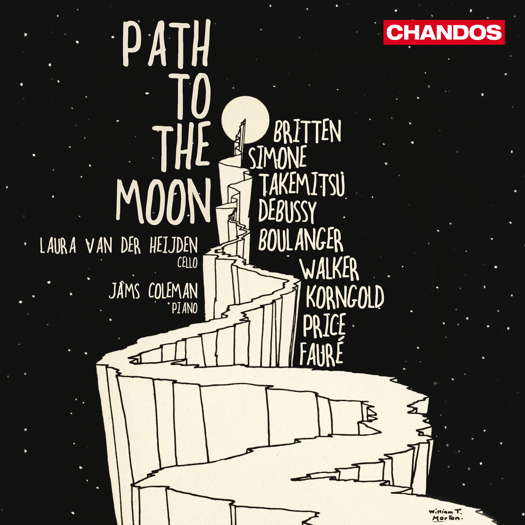- Jaime León
- The Wasps
- Wolfgang Rihm
- Gailene Stock
- Duncan Druce
- Prokofiev: Symphony No 5
- Dorset
- George Easton
 VIDEO PODCAST: Slava Ukraini! - recorded on the day Europe woke up to the news that Vladimir Putin's Russian forces had invaded Ukraine. Also features Caitríona O'Leary and Eric Fraad discussing their new film Island of Saints, and pays tribute to Joseph Horovitz, Malcolm Troup and Maria Nockin.
VIDEO PODCAST: Slava Ukraini! - recorded on the day Europe woke up to the news that Vladimir Putin's Russian forces had invaded Ukraine. Also features Caitríona O'Leary and Eric Fraad discussing their new film Island of Saints, and pays tribute to Joseph Horovitz, Malcolm Troup and Maria Nockin.
 FEEDBACK: She said WHAT? Read what people think about our Classical Music Daily features, and have your say!
FEEDBACK: She said WHAT? Read what people think about our Classical Music Daily features, and have your say!

A Great Release
GEOFF PEARCE appreciates Laura van der Heijden and Jâms Coleman's cello and piano recital
'... the performers do not appear to be recorded with microphones too close, which results in realistic blending, and also a feeling of distance, perhaps reflecting the distant and mysterious qualities of the moonlight.'
This very interesting disc presents a lot of music that I was unfamiliar with and is quite varied in content. I had heard of the cellist, Laura van der Heijden, before, but pianist Jâms Coleman was not known to me. This album also introduced me to George Walker, a composer I had never heard of before.
The first work on the disc, Schönste Nacht, Op 36 No 25 (1946), was originally a song from a larger work, Die stumme Serenade - the last stage work written by Erich Wolfgang Korngold. This light, rather sentimental piece, requiring and receiving a beautiful cantabile treatment and finely felt rubato, is here arranged for cello and piano.
Listen — Korngold: Schönste Nacht
(CHAN 20274 track 1, 0:02-0:42) ℗ 2024 Chandos Records Ltd :
The second piece is quite substantial: the melodic and inventive 1957 Cello Sonata by George Walker, in three contrasting movements.
The first movement starts in a rather impassioned way, but soon relaxes. This does not last, though, as there are outbursts of rather restless music sandwiched between more reflective passages. Both artists provide a compelling account.
The second movement, 'Sostenuto', is, for the large part, sorrowful yet reflective. The cello provides most of the melodic interest and the piano writing is mostly in the background, but this partnership works very well, and the piano comes to the fore when required. This is quite magical, thoughtful and sometimes questioning. One cannot help but wonder why this work is not performed more often.
Listen — George Walker: Sostenuto (Cello Sonata)
(CHAN 20274 track 3, 4:02-4:45) ℗ 2024 Chandos Records Ltd :
The short final movement has a lot of energy and syncopation, and one can hear the influence of jazz, which is something that this composer often incorporates. There is also a little anger here.
The next work, Reflets, a little song by Lili Boulanger, works perfectly with cello and piano. It has moments of reflection and also passion. I had not heard this before.
Listen — Lili Boulanger: Reflets
(CHAN 20274 track 5, 2:06-2:40) ℗ 2024 Chandos Records Ltd :
Florence Price's Night was composed in 1946, and again is a transcription of a song. It is a reflective piece with a tender yet longing atmosphere, and one to be enjoyed.
The next work, Sonetto XXX (1940), is by Benjamin Britten and was originally part of the larger work, Seven Sonnets of Michaelangelo, of which this is number three. Originally for tenor and piano, it is a lyrical and heart-felt piece.
This is followed by Britten's five movement Cello Sonata in C major, which is the longest work on the disc. It was written for Rostropovich, completed in 1961 and first performed the same year by Rostropovich and the composer.
The first movement, 'Dialogo', is, as the title suggests is a dialogue between cello and piano, and is quite tempestuous shortly after a tranquil start. The tranquillity resumes but again the passionate nature reasserts itself and this pattern repeats. The artists here provide a compelling account of this virtuoso piece.
The second movement, a scherzo, is at times, both light-hearted and passionate, with quick changes of mood. The cello largely plays pizzicato.
The third movement is an elegy, sorrowful and sombre in character. This is the emotional core of the work, requiring considerable dynamic control, and again the artists show the full range of emotion required.
Listen — Britten: Elegia (Cello Sonata)
(CHAN 20274 track 10, 4:50-5:31) ℗ 2024 Chandos Records Ltd :
The next movement, 'Marcia', requires great rhythmic precision, and would be physically demanding to play. This is a marvellous performance.
The last movement, 'Moto Perpetuo', is a tour de force, delivered with the virtuosity and agility that this movement requires. It is as fine a performance of this work as I have ever heard.
This is followed by an early song of Debussy (circa 1880) called Beau Soir, which has been transcribed for cello and piano. It is a rather subdued and dreamy piece, beautifully performed, with a perfect balance achieved between piano and cello.
Gabriel Fauré's Clair de Lune was composed in 1887 as a song, so this is another transcription. (This is a piece I had not heard before.) The piano introduction is quite extensive before the cello enters, and again, this piece is played with great affection.
Listen — Fauré: Clair de Lune
(CHAN 20274 track 14, 1:27-2:14) ℗ 2024 Chandos Records Ltd :
Next comes the Debussy Cello Sonata. This was composed in 1915, and was first performed with Debussy at the piano a couple of years later. It is relatively short, just over eleven minutes, and in three movements.
The first movement, 'Prologue', begins on the piano before the cello enters. There are a few mood and tempo changes over the four-and-a-half minutes of this work, including one quite tempestuous section that slowly resolves to the calmness of the opening. This is quite surprising music - reflective and questioning.
Listen — Debussy: Prologue (Cello Sonata)
(CHAN 20274 track 15, 1:47-2:40) ℗ 2024 Chandos Records Ltd :
The second movement, 'Serenade', again has a lot of contrast of tempi and mood. I find it quite skittish and nervous overall, with the exception of the last third, where it calms down, tries to return to the opening, but this does not amount to anything, and finishes quietly and calmly.
In keeping with the two previous movements, the third contains a lot of contrast, and one's attention never wavers. There are rather gruff and fiery sections, and others that are playful, plus one soft slow passage that melts away, but the piece ends as it began with a flourish.
Another work that was totally unfamiliar to me is the song Will Tomorrow, I Wonder, Be Cloudy or Clear? by Toru Takemitsu. It was originally written for choir, but later arranged for cello and piano. This short work from about 1992 is rather sentimental and touching, and is unlike anything of this composer that I had heard before. It has a cabaret song quality and would make a great little encore piece.
Listen — Takamitsu: Will Tomorrow, I Wonder, Be Cloudy or Clear?
(CHAN 20274 track 18, 1:20-1:59) ℗ 2024 Chandos Records Ltd :
This is followed by a song by Nina Simone, a singer and pianist that I have admired for a long time. This is an arrangement of Jonathan King's song Everyone's Gone to the Moon, and Simone's version was released at the time of the Apollo 11 moon landing in 1969. The piano writing is grand and theatrical.
Listen — Jonathan King, arranged by Nina Simone:
Everyone's Gone to the Moon
(CHAN 20274 track 19, 1:46-2:40) ℗ 2024 Chandos Records Ltd :
The final work on the disc, Debussy's Clair de Lune, needs no introduction and is a fitting closing piece on a recording with a lunar theme. I have loved this work since I was a young child, much to my father's disgust, as he did not like Debussy at all, being forced to learn Golliwog's Cakewalk as a boy. This is sensitively played with great atmosphere.
This is a great release, with fine artists, quite a range of contrasting music, and informative programme notes. I think this disc will appeal to a very wide section of the listening public. One thing I particularly liked is that the performers do not appear to be recorded with microphones too close, which results in realistic blending, and also a feeling of distance, perhaps reflecting the distant and mysterious qualities of the moonlight.
Copyright © 20 February 2024
Geoff Pearce,
Sydney, Australia



